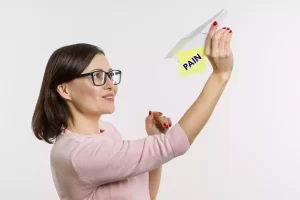
PAINFUL MENSTRUATION
Home » Chronic fatigue and burnout » PAINFUL MENSTRUATION
MENSTRUAL CYCLE PROBLEMS, DYSMENORRHEA, AMENORRHEA AND RED LIGHT REFLEX
• I’ve noticed that women who have problems with the menstrual cycle manifest activated red light reflex.
• A woman has abdominal distension, and she cannot relax her abdominal muscles, her shoulders, neck and head are pushed forward.
• A few active therapies of the AEQ method® improve the ability to lower average tonus of the abdominal muscles.
• The pain stops during menstruation; the menstrual cycle becomes regular again.
50 % to 90 % of women occasionally have problems with painful menstruation (Dysmenorrhea).
Dysmenorrhea is the medical term for menstrual cramps caused by uterine contractions, and it is similar to contractions at childbirth. The uterus (which is a muscle) mildly contracts throughout a woman’s menstrual cycle, however, uterus contracts more strongly during menstruation, and spasms are even stronger during childbirth. If the uterus contracts too strongly, it can press against nearby blood vessels, cutting off the supply of oxygen to the muscle tissue of the uterus — pain results when part of the muscle briefly loses its supply of oxygen and releases a chemical called prostaglandin. Spasms have a function to shed the uterus’ lining during menstruation, then the lining of the uterus thickens again and prepares for the egg. If pregnancy does not occur, the lining is released in what is known as menstruation, and the whole process repeats in a month. Women wonder whether pain during menstruation is something normal. Pain is usually in the pelvis or lower abdomen, and it starts the first day of menstruation, sometimes earlier.
Stress is one of the causes of amenorrhea, which is the absence of menstruation, but also one of the reasons for the irregular menstrual cycle. When in stress, the human body becomes tense and starts secreting cortisol, which can, when its level is high enough, suppress the production of other hormone GnRH (gonadoliberin or gonadotropin hormone-releasing hormone is a decapeptide hormone secreted by the hypothalamus). Absence of the GnRH hormone causes shorter or longer periods without menstruation as the GnRH informs the reproductive hormones to thicken the uterus and to release the egg. When the level of cortisol decreases, the level of GnRH increases and the cycle continues. This is a common disorder at professional athletes. Most of them believe that this is normal due to their long, hard and exhausting training that is necessary for the top performance, but the truth is women could prevent amenorrhea.
I’ve noticed severe signs of the red light reflex at women with menstrual disorders. This type of reflex is also the cause for most of the problems with female reproductive organs as well as for issues at childbirth. The red light reflex tightens the muscles on the front of the body, which results in limited and difficult abdominal breathing and increases abdominal pressure. Various problems occur with time, like problems in the functioning of different body systems, problems with blood circulation, hormonal imbalance and eventually menstrual disorders. A woman’s abdominal muscles are extremely tight, and she cannot relax them, shoulders are rounded, the chest is depressed, and the head is jutting forward. Also, her breathing is obstructed, and she has a hard time sitting with straight back or standing. Several active therapies of the AEQ method® improve the ability to relax the abdominal muscles in just a few months.
Further, a client also gains a sense of control over the muscles of the front of the body hence preventing their tightening. The results are lower stress level, relaxation, calmness – all that contributes to creating conditions for the normal functioning of all organs. Menstrual pain is reduced or even eliminated, and the cycle becomes regular. The menstrual cycle is a reliable indicator of the general health, so make sure the menstruation is regular and painless. If it’s not, stand in front of the mirror and assess whether your posture shows signs of the red light reflex. Consider the AEQ method® therapy and whether you could benefit from it – regain relaxed posture, effortless and efficient breathing and sense of self-control and self-expression.
Aleš Ernst, author of the AEQ method and AEQ breathing






